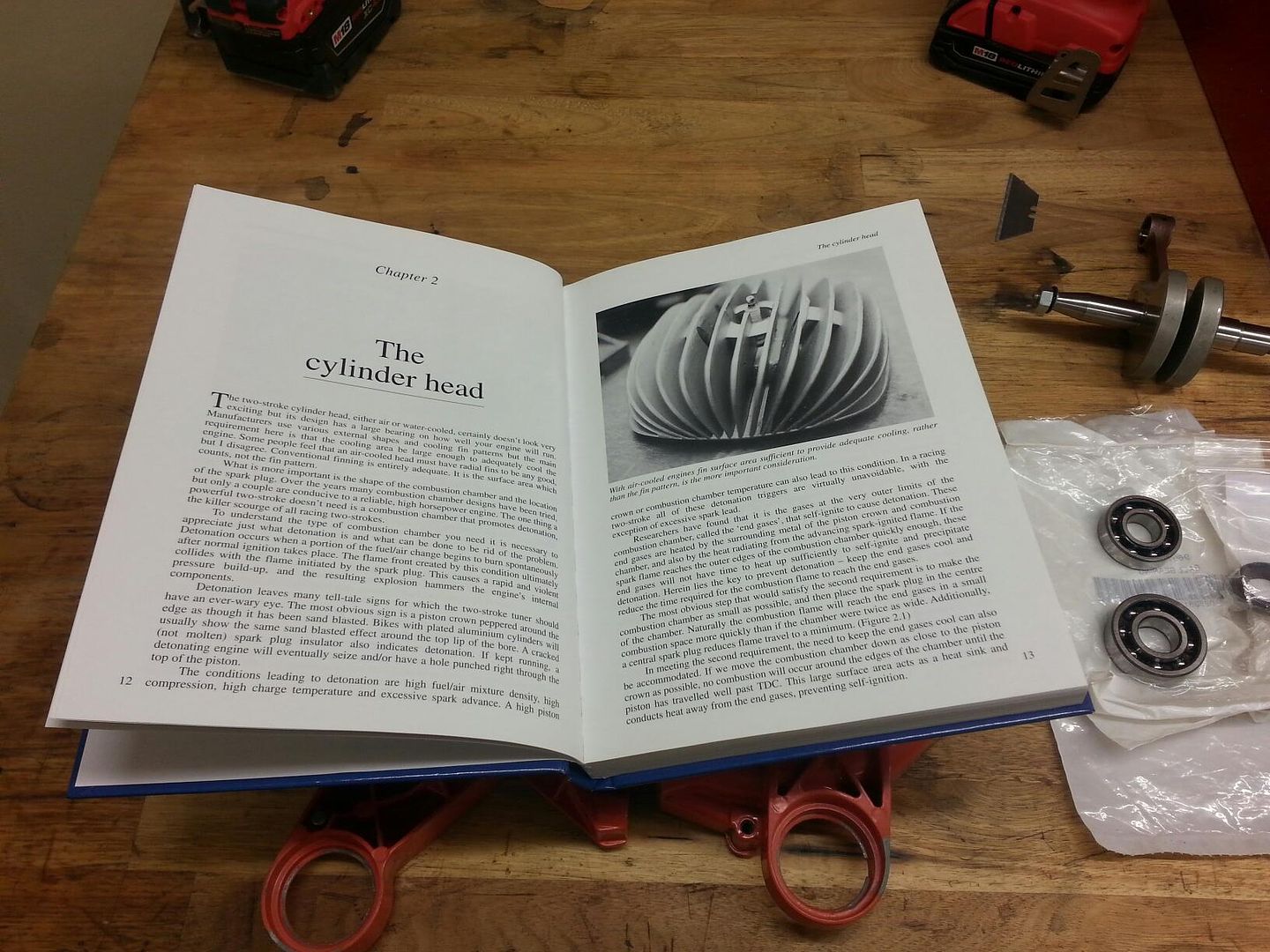Frits Overmars:
I too use solder: 0,8 mm wire with hollow resin core because that is softer and does not put so much strain on the
big-end bearing when it gets flattened. I use two pieces of soldering wire simultaneously, left and right above and parallel to the piston pin, so the piston won't tilt in any way. That gives you the static squish gap.
To find the dynamic gap you need some nerve: just put it together, run it and open it up. My rule of thumb is: 'If I cannot clearly see that the piston has kissed the head, everything is fine'.
I will say a bit more about this later; I am preparing some more text about squish.
The higher the squish velocity, the better. Combustion should be as fast as possible (apart from detonation) and squish turbulence helps.
So are there no negative sides to a high squish velocity? In theory no; in practice the ignition may not be up to it. I will try to explain later.
So here goes.
You must be able to rely on the ignition, even when the electrode gap has gotten on the big side, when the mixture is so weak, rich or diluted that you can hardly ignite it, or when the compression end pressure is high because of good cylinder filling or a high compression ratio.
All parts of the ignition system are important: the spark plug of course, but also the plug lead (never use carbon core leads), the plug cap (never use
resistor caps; if there has to be a resistor in the high tension line, it sould be inside the plug, not in the cap, because caps fail), the coil (with Jamathi, Bultaco and Garelli the fat, blue, oil-filled Bosch coils were used despite the fact that they were almost as heavy as the engine. Replacing them with slim Japanese coils cost several hp...)
Let's take a look at the spark plug. What exactly happens there when the coil sends its high tension voltage? The gas molecules between the electrodes are ionized by the high potential. Starting at one of the electrodes, the ions begin to form a conductive channel through the otherwise non-conductive gas and as soon as this channel reaches the other electrode, a connection is established and a current starts to flow: the spark.
The ionisation needs a certain voltage per mm electrode gap, dependent on temperature and pressure of the gas. The squish turbulence can blow the ions away before they have had a chance to form a channel from one electrode to the other. Then, when the channel is finally completed, it is no longer straight but arched, also longer. Because of the required voltage per mm you then need a higher ignition tension.
Some time ago Honda RS125s would not run with more than 0,4 mm electrode gap, whereas Aprilia used 0,7 mm gap. Then Honda offered a kit with a different (better!) ignition system...
Talking about better ignition systems: our fellow forum member Emotracing offers something nice:
an ignition extension. The normal ignition takes care of the ionisation channel; then as soon as the current starts to flow, the Emot-set sends a
big extra current through this channel. It looks like this: [Vous devez être
inscrit et
connecté pour voir ce lien]
And if you really want to know all about sparks, look here:
There is one other possible objection against effective squish. When a gas comes in contact with a solid surface, it tries to cling onto it: it forms a boundary layer. This layer of stationary gas is a fairly good
heat insulator. The piston crown enjoys this insulation, as the boundary layer protects it from the combustion heat. In theory the squish flow can blow the boundary layer away, exposing the piston directly to the combustion.
But there is always a far greater danger: detonation. The shock waves in a detonating engine are a thousandfold more effective in shaking the boundary layer loose. So I prefer a good squish that speeds up combustion.
If detonation occurs, it happens in the end phase of combustion, when the pressure in the combustion chamber is high and the temperature of the unburnt mixture in the edges of the chamber is raised by the heat radiation of the burning mixture.
Effective squish flings burning parts of the mixture to the edges of the combustion chamber, igniting all mixture before detonation factors there can reach a
dangerous level.
Finally a simple advise for junior tuners: make the squish gap so tight that there is no more room for mixture; if it is not there, it cannot detonate 8)
Institute of TwoStrokes a écrit:
Frits, Do you think that the torriodal shape has less cyclical variation(less variation between a 'good' and 'bad' combustion cycle)? Allowing more consistent jetting and ignition timing.
The Toroidal shape has proven to give better power; that
might come from fewer bad combustion cycles. It can be measured, but I have no relevant data available.
Frits Overmars:
I have seen a few CFD simulations, that show a great deal of turbulence (small fast spinning eddies) coming off a small radius at the inner edge of the
squish band.
CFD programs have improved tremendously over the years, but the saying still applies:
garbage in = garbage out; it all depends on what you feed these programs. I do believe in these
micro-eddies at the inner edge of the squish band though; it is mr.
Coanda making himself noticed.
At Aprilia Jan Thiel performed a series of tests with different radii at this edge. The outcome was crystal-clear: R=0 was best and the bigger the radius, the worse the result. It is all the more surprising that Honda has always stuck to a radius (sometimes as large as 5 mm).







